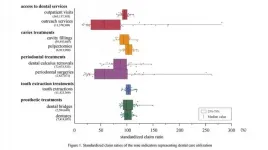INFORMATION:
Video:
https://youtu.be/x-ynGBydOSA
An unusual symbiosis of a ciliate, green alga, and purple bacterium
2021-06-14
(Press-News.org) Dr Sebastian Hess and his team at the University of Cologne's Institute of Zoology have studied a very rare and puzzling tripartite symbiosis. This consortium consists of a ciliate as host and two types of endosymbionts: a green alga and a previously unknown purple bacterium. Through genetic analyses of the pink-green ciliate, the researchers discovered that the endosymbiotic bacterium belongs to the so-called 'purple sulfur bacteria' (family Chromatiaceae), but has lost the ability to oxidize reduced sulfur compounds, a hallmark of the other members of the Chromatiaceae. The genome of the purple bacterium is greatly reduced, suggesting that the bacterium became mainly specialized in carbon fixation through photosynthesis. It is probably no longer able to live outside of the host cell. Thus, the new bacterial species "Candidatus Thiodictyon intracellulare" is a notable exception among the known purple sulfur bacteria. In their article 'A microbial eukaryote with a unique combination of purple bacteria and green algae as endosymbionts' published in Science Advances, the researchers report the new findings and explain how the oxygen-sensitive purple bacterium lives together with the oxygenic green alga in the ciliate host.
The pink-green ciliate Pseudoblepharisma tenue inhabits the hypoxic sediments in the ponds of the 'Simmelried', a moorland near the German city of Constance. Dr Martin Kreutz, an amateur microscopist and friend of Dr Hess, has been observing the occurrence of this unusual life form for several years. Since the ciliate could not be cultivated in the laboratory so far, a lively collaboration has developed between Dr Kreutz and the UoC researchers. Dr Kreutz took the samples and sent the fresh sediment to Cologne by mail. In Cologne, the researchers isolated single cells of Pseudoblepharisma tenue from the samples and analysed them with various microscopic and genetic techniques.
The first author of the study, Dr Sergio Muñoz-Gómez, reconstructed the genomes of the three symbiotic partners and demonstrated the massive physiological reduction of the endosymbiotic purple bacterium. 'Based on our observations in natural samples, the microscopic details of the symbiotic consortium, and the genomic data an interesting picture emerges. Symbiosis has given rise to a unique chimeric creature: a motile and voracious cell that, at the same time, uses light energy from anoxygenic photosynthesis to inhabit the deep and oxygen-poor layers of ponds,' the researchers said. 'The green algae seem to play a minor role. Instead, the crucial physiological contribution comes from the oxygen-sensitive purple sulfur bacteria.'
ELSE PRESS RELEASES FROM THIS DATE:
Researchers model impact of blood pressure control programs at barbershops nationwide
2021-06-14
Boston - Hypertension, or high blood pressure, kills more Americans than any other health condition. It is especially prevalent in Black Americans and is exacerbated by structural barriers to accessing high quality healthcare. In a 2018 randomized trial called the Los Angeles Barbershop Blood Pressure Study (LABBS), barbers were trained to screen their Black male patrons for hypertension and refer them to a pharmacist who visited the barbershop to counsel and treat individuals with high blood pressure. Participants in the barbershop-based, pharmacist-led program saw a 20-point drop in systolic (top number) blood pressure that they were able to sustain ...
Climate conditions during the migration of Homo sapiens out of Africa reconstructed
2021-06-14
An international research team led by Professor Dr Frank Schäbitz has published a climate reconstruction of the last 200,000 years for Ethiopia. This means that high-resolution data are now available for the period when early Homo sapiens, our ancestors, made their way from Africa to Europe and Asia. Schäbitz and his colleagues determined the dates using a drill core of lake sediments deposited in southern Ethiopia's Chew Bahir Basin, which lies near human fossil sites. Temporal resolution of the samples, reaching nearly 10 years, revealed that from 200,000 to 125,000 years before our ...
The evolution of good taste
2021-06-14
Does evolution explain why we can't resist a salty chip? Researchers at NC State University found that differences between the elemental composition of foods and the elemental needs of animals can explain the development of pleasing tastes like salty, umami and sweet.
Taste tells us a lot about foods before they are swallowed and digested, and some tastes correspond with the elemental composition of foods. For example, an aged steak lights up the umami taste receptors, because it has a high concentration of the element nitrogen, which occurs in amino acid molecules. Nitrogen is essential for survival, but often occurs in low concentrations relative ...
Study finds survival is more important than a chronic medical condition in prioritizing medical care
2021-06-14
(Boston)-- The concept of rationing medical resources during the height of COVID-19 pandemic created tremendous anxiety in the patient and healthcare communities. In planning for that possibility Massachusetts created a triage scoring system focusing on an acute survival score that considers chronic life-limiting medical conditions of the patient, but it does not provide specifics about how to value those conditions in the equation.
Now a new study supports prioritizing resources to those who are most likely to survive an acute illness as several chronic medical conditions had less of an impact on longer-term survival than previously suspected.
"No one ...
Study reveals factors that shape Haitian Creole-speaking women's birth plans after C-sections
2021-06-14
(Boston)--Despite evidence regarding the benefits of vaginal birth after cesarean and recommendations to support shared decision making to reduce cesarean rates, minority women face many impediments that limit their access to appropriate health information and opportunities for such discussions.
Haitian women in Massachusetts have the highest rates of cesarean section and low rates of vaginal birth after cesarean, despite evidence suggesting that many are eligible to attempt vaginal birth after a previous cesarean.
Now a new study explores how Haitian women's beliefs, values and attitudes influence their decision making about pregnancy and birth after having had a cesarean delivery. In conjunction with the providers' views about Haitian women, the information ...
Breeding foxes for opposite behaviors produces similar brain changes
2021-06-14
Farmed foxes selectively bred for tameness and aggressiveness exhibit similar changes to their brain anatomy, according to research recently published in JNeurosci. Both lineages also have larger brains than conventional farm-bred foxes, complicating leading theories on domestication.
Domesticated species provide insight into complex evolutionary processes on a condensed timeframe. When a species splits from its wild counterpart, its brain, body, and behavior undergo rapid changes. Studies with chickens, sheep, cats, dogs, and more indicate domestication shrinks the brain. But the same pattern does not extend to foxes in the expected way.
Hecht et al. used MRI to measure the brain size ...
Domesticated foxes display increased size in brain regions
2021-06-14
When Erin Hecht was earning her Ph.D. in neuroscience more than a decade ago, she watched a nature special on the Russian farm-fox experiment, one of the best-known studies on animal domestication.
The study, running since 1958, tries to replicate the natural domestication of wolves to dogs by selectively breeding two strains of silver foxes so they exhibit certain behaviors. Scientists breed one to be tame and display dog-like behaviors with people, such as licking and tail wagging. The other is bred to react with defensive aggression when faced with human contact, while a third strain acts as the control and isn't bred for any specific behaviors.
Hecht, who's now an assistant professor in the Harvard Department of Human ...
A step closer to a hydrogen-fuelled economy using an efficient anode for water splitting
2021-06-14
Niigata, Japan - In the recent past, there has been a paradigm shift towards renewable sources of energy in order to address the concerns pertaining to environmental degradation and dwindling fossil fuels. A variety of alternative green energy sources such as solar, wind, hydrothermal, tidal etc., have been gaining attention to reduce the global carbon footprints. One of the key challenges with these energy generation technologies is that they are intermittent and are not continuously available.
"We cannot use solar energy at night and wind energy when the wind is not blowing. But we can store the generated electricity in some other forms and utilize it whenever required. That is how water splitting bridges the gap and has emerged as a very promising energy storage ...
Gaps to fill: Income, education may impact inequalities in seeking dental care
2021-06-14
Tsukuba, Japan - Inequitable access to health care is a pressing global health concern, and care of our teeth is no exception. In fact, the World Health Organization established the Global Goals for Oral Health 2020 in its efforts to help counter socioeconomic-related imbalances. Economically advanced Japan has plentiful dentists, as well as a universal health insurance system, yet it also has oral care-related inequities, according to a new study.
A team of researchers centered at University of Tsukuba in Japan examined a huge set of claims and checkup data in search of regional and socioeconomic trends. Their findings included the key observation that regional lower ...
New research shine light on perovskite solar cell performance
2021-06-14
The potential of a class of materials called perovskites to enable solar cells to better absorb sunlight for energy production is widely known. However, this potential has yet to be fully realised, particularly under real-world operating conditions.
New research published today in the prestigious journal Nature Energy, has revealed defects in a popular perovskite light absorber that impede solar cell performance. The researchers found a change in the nature and density of these 'intragrain planar defects' correlated with a change in solar cell performance.
The discovery by an international team of researchers, led by Monash ...



